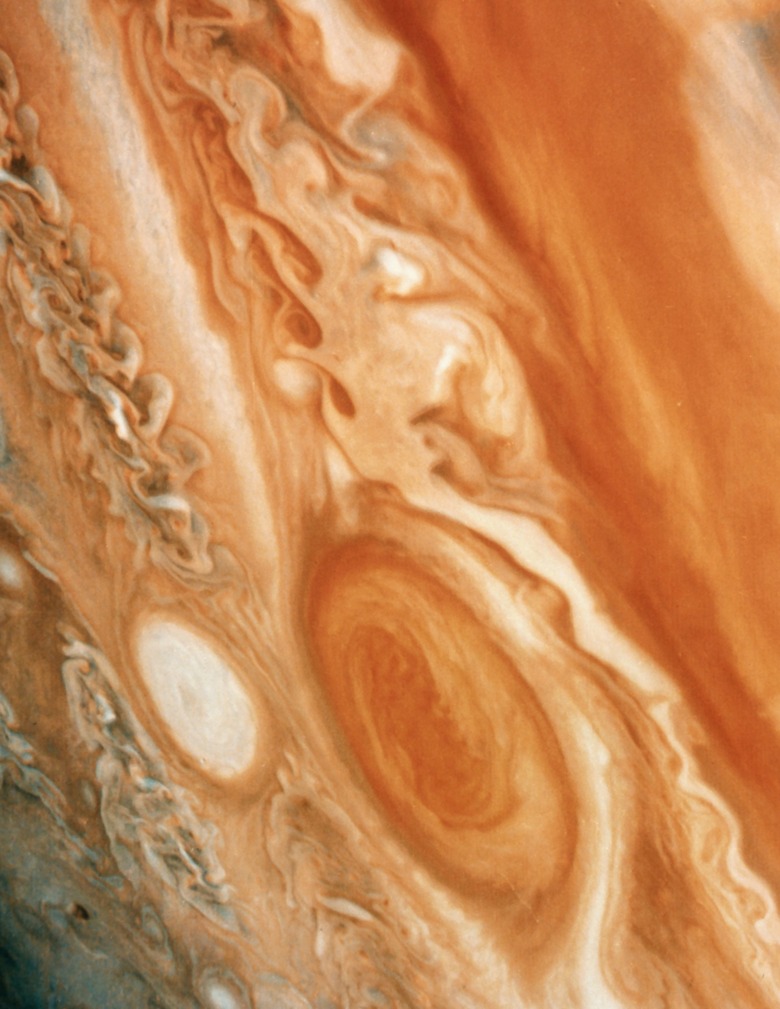What Is The Weather On Other Planets?
Humanity's exploration of the solar system has revealed much about the conditions on other planets. While no other planet shares the atmospheric makeup that has made Earth the home to so much life, many of them share aspects of Earth's meteorology. The weather conditions on other planets result from the unique conditions of their makeup and orbital characteristics.
Mercury
Mercury lies closest to the sun, and the powerful solar wind pushes the planet's meager oxygen and sodium atmosphere away like a comet's tail, while at the same time replenishing it. Temperatures range from 425 degrees Celsius (about 800 degrees Fahrenheit) during the day to -200 Celsius (about -330 degrees Fahrenheit) at night because its atmosphere is too thin to hold heat.
Venus
Venus's atmosphere is extremely dense, resulting in temperatures hot enough to melt lead. The upper layers of the planet's atmosphere are home to violent lightning storms, but these disturbances rarely pierce the dense layers of gas near the surface.
Mars
Mars is a cold, dry world with average temperatures around -63 degrees Celsius (-81 degrees Fahrenheit). The primary weather on the planet consists of dust storms, and while there is no liquid water on the planet, probes occasionally develop layers of frost crystals during the long, cold nights.
Jupiter
Jupiter is a gas giant, consisting of clouds of hydrogen and helium gas surrounding a small, dense, extremely hot rocky core that may reach nearly 20,000 degrees Celsius (36,000 degrees Fahrenheit). The planet is home to extremely long-lived and violent storms such as the Great Red Spot, a cyclonic vortex that has lasted for more than four centuries.
Saturn
Saturn is very similar in composition to Jupiter, although much of its helium atmosphere is falling into its core, liquefied by the intense pressure. Saturn boasts tremendous straight-line winds, reaching as high as 1,000 miles per hour (more than 1,600 kilometers per hour) at the planet's equator. Saturn's poles are also home to hexagonal superstorms, first photographed by the Voyager probes as they passed the ringed world.
Uranus
Uranus is a smaller gas giant than its cousins, but contains many of the same features. Its average temperature of -193 degrees Celsius (-315 degrees Fahrenheit) leaves it shrouded in clouds of methane and ammonia ice crystals. Its eccentric orbit leaves one pole pointed away from the sun for decades at a time, triggering massive storms when the frozen side rotates sunward and begins to thaw.
Neptune
Wind speeds of up to 1,200 miles per hour (1,931 kilometers per hour) push methane ice clouds through the hydrogen atmosphere of Neptune. Periodically, holes in the dense cloud deck offer a glimpse into the depths of the planet, home to another intensely hot core that keeps the world from freezing whole.
Pluto
Pluto and the other minor planets in the outermost reaches of the solar system share similar meteorological conditions. Though information about these distant worlds is limited, observations suggest they have thin, relatively calm atmospheres above fields of nitrogen and methane ice. Temperatures range below -227 degrees Celsius (-378 degrees Fahrenheit).
Cite This Article
MLA
Kazmeyer, Milton. "What Is The Weather On Other Planets?" sciencing.com, https://www.sciencing.com/weather-other-planets-4250/. 24 April 2017.
APA
Kazmeyer, Milton. (2017, April 24). What Is The Weather On Other Planets?. sciencing.com. Retrieved from https://www.sciencing.com/weather-other-planets-4250/
Chicago
Kazmeyer, Milton. What Is The Weather On Other Planets? last modified March 24, 2022. https://www.sciencing.com/weather-other-planets-4250/
